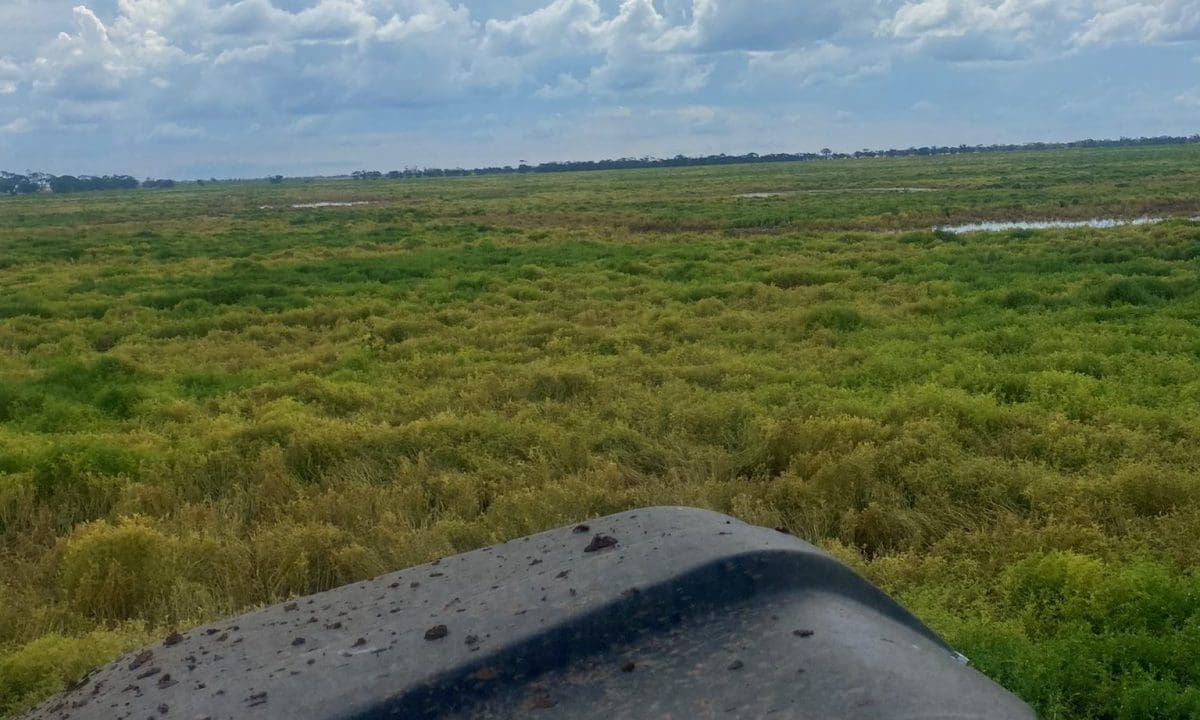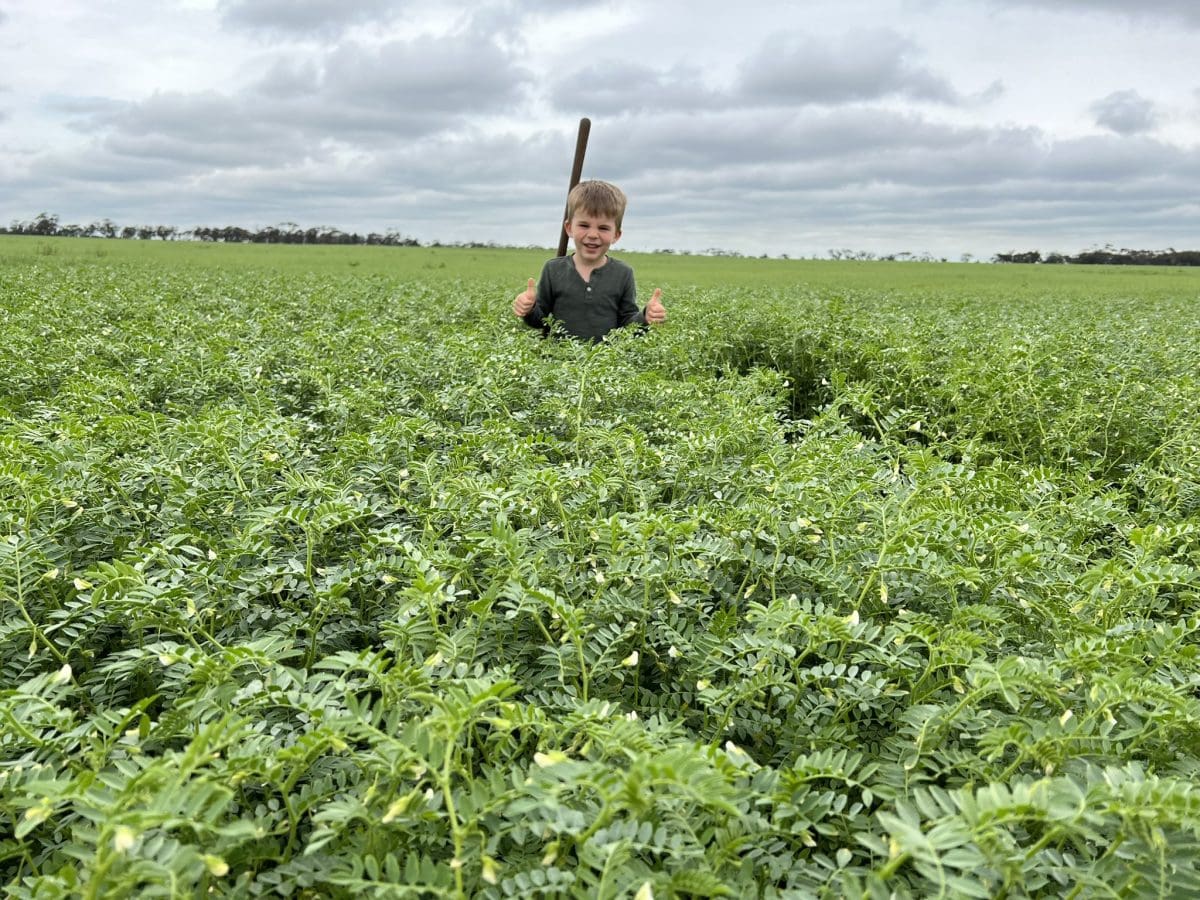
Waterlogging has written off an estimated 75pc of this grower’s lentil crop in the Victorian Mallee as wet weather continues. Photo: Mick Foott
SUCCESSIVE rain is causing significant quality problems and yield losses in many parts of eastern Australia, with chickpeas, lentils and faba beans hard hit.
Early estimates say production of the three pulses could be down by around one third on what was expected in mid-September, and their only value will be as nitrogen sources for next year’s cereals.
However, districts that have undulating country and/or free-draining soils are looking at bumper yields as late crops get later, and flourish in the unusually mild and wet spring.
Trade and agronomy sources say pulse crops overall in New South Wales and Victoria will struggle to reach their yield potential as fungal diseases and waterlogging pressure or write off crops.
On the positive side, lentils in South Australia and lupins in Western Australia are heading towards bumper or even record yields, and wet conditions are setting NSW and Queensland up for a record mungbean plant in December-January.
Chickpeas
Based largely on the depreciating Australian dollar, prices for chickpeas with minor weather damage have firmed to around $480-$485 per tonne delivered Downs packer in extremely thin volume.
In Central Queensland, consultant Jamie Iker said chickpeas were yielding 2.5-4 tonnes per hectare, close to double the norm thanks to ample moisture from planting through to harvest.
However, rain in the past week has impacted quality.
Mr Iker said a paucity of delivery options for downgraded peas has growers prioritising cereals over chickpeas in their harvest schedules.
“Not a lot of peas have come off yet, and they aren’t making CHKP 1 grade, so growers are getting their wheat and barley off first; they’ll store chickpeas on farm,” Mr Iker said.
While the CQ area is down, Mr Iker said above-average yields will lift production to a par with last year, and new-crop bulk shipments are scheduled to start in December.
Botrytis grey mould (BGM) is evident in many CQ crops, and will make grading necessary for them to meet export standards.
In southern Queensland, chickpeas have been planted to a reduced area on the western Downs, and conditions are generally good for crops on light and undulating country.
While ABARES September 2022 estimate for Queensland’s chickpea production looks reasonably stable at 320,000t from 205,000ha, the NSW estimate of 252,000t from 180,000ha is expected to plummet.
In northern NSW, prospects from an already reduced area have been decimated by BGM and waterlogging, with the key producing regions around Moree and Narrabri among the hardest hit by flooding in recent days.
Most NSW growers have little chance of getting on top of BGM with paddocks likely to be untrafficable for at least a fortnight.
In Victoria, ABARES’ forecast for 35,000t from 25,000ha looks achievable, with some thriving Mallee crops offsetting waterlogging and disease loss in others.

This crop of chickpeas in the Mallee has stayed on top of wet conditions. Photo: James Considine, Syngenta
Faba beans
Prices for faba beans are largely unchanged from last month at around $350/t delivered packer for prompt and new-crop, now that bulk shipping of old-crop is out of volume in a flat export market.
ETG southern pulse trader Todd Krahe said old-crop stocks in grower hands appear to be limited.
“A lot of growers offloaded beans two months ago,” Mr Krahe said.
ABARES in September forecast the national faba bean crop at 463,000t from 242,000ha, and a reduction of at least one third now seems likely for area and tonnage.
Quality of around half of what is left appears highly likely to be downgraded.
Some crops have been abandoned due to the impact of chocolate spot, while some growers are continuing to spray fungicide in the hope of controlling the disease and maximising record yield potential.
“Guys have spent a lot of money on fungicides, and they’re that far in, they’ve got to keep spending.” Mr Krahe said.
While several runs of hot and dry days can be expected past the halfway mark in spring, no such event has been seen to date in NSW and Victoria, and Sparke Ag Horsham-based agronomist Matthew Sparke said chocolate spot losses were already considerable.
“There’s no heat; nothing’s wanting to flower and pod, and we’ve got Bendocs with 3 feet of stem and two leaves on top.”
“We’re in a lot of trouble down here; we’ve got Bendoc faba beans not coping.”
While the Amberley variety, predominantly grown in districts with the longest growing season, appears to cope with disease pressure, Mr Sparke said the Samira variety was also suffering.
In the face of high urea prices, even abandoned faba bean crops will have some benefit as green or brown manure crops which fix nitrogen ahead of next year’s crop.
Lentils
Prices for lentils have risen by roughly $100/t in the past month to around $800/t, with the drop in the Australian dollar behind the rally.
“We have seen a spike in lentil prices in the past fortnight or month, and a lot of it is to do with our currency,” Mr Krahe said.
At least two bulk cargoes of lentils have left Australian shores this month, and these have pretty much mopped up the last volume parcels of old-crop.
Some growers are hanging on to old-crop stocks, and Mr Krahe said they were unlikely to let them go while conditions remained wet.
“There’s definitely interest in old-crop from overseas, but based on the forecast for more rain, growers are holding it as a bit of hedge.
“Trade’s been pretty thin.
“Everyone’s concerned about the next 2-3 months.”
ABARES September forecast puts Australian lentil production at a record 924,000t from a record 576,000ha, but a drop of around 30pc on both numbers is now seen as likely, largely because of waterlogging and disease in Victoria.
Lentils crops throughout South Australia are generally in excellent condition as rain events have been smaller and more spread out than those in eastern states.
Some crops in the northern and western Victorian Mallee are also in good stead.
The later Wimmera crops are battling BGM, but those that have not been waterlogged could still yield above average.
“In the Mallee, where crops haven’t been waterlogged, they could have yields never seen before.
Mr Sparke estimates up to 30pc of his clients’ lentil crops are write-offs, and one client is now expecting less than 20pc of the 5000t he had pencilled in back in August for this harvest.
“That dropped to 1500t, and now he’s budgeting on 800t.”
Mungbeans
Some growers in western NSW have taken the unprecedented step of sowing mungbeans, and the area planted to the summer pulse could well be a record.
Its short growing season means it could well be the crop of choice for growers who are unable to plant cotton, which is off to a horror start because of flooding in NSW.
“The later it gets, the more mungs will go in,” Australian Choice Exports director James Hunt said.
Seed sales indicate mungbeans will be sown well beyond their normal heartland of Queensland and northern NSW, and price prospects for the April-May crop have lifted $50/t to $1300/t for No. 1 grade, $1200/t for processing and $1100/t for manufacturing.
The later May-June crop is sitting at $100/t less for each grade.
China is the biggest importer of Australian mungbeans, while now was the off season for Chinese demand, buying is expected next year as it looks to fill its shortfall.
“Mungbean prices are pretty solid, and drought in China meant their crop wasn’t massive,” Mr Hunt said.



HAVE YOUR SAY